|
DELTA-11: 2012 Riding Season Pictures and Notes By Kraig Schultz |
Charging Station Lessons - April 25, 2012 Here's a picture of the Delta-11 in with the charging station in downtown Grand Rapids with our well known landmark the CALDER. I'm learning that if my meeting and errand running destinations had plug in's I would be almost fully charged after every stop. The lesson is that plugging in must be very easy - maybe a cord reel mounted on the bike with easy access to plug-ins - to allow for fast plugins at every stop? |
|
Earth Day Fair in Muskegon - April 28, 2012 We displayed the Delta-12 proto-type and had a working motor control circuit for people to play with. The bike and motor were a big hit with the kids (young and old). 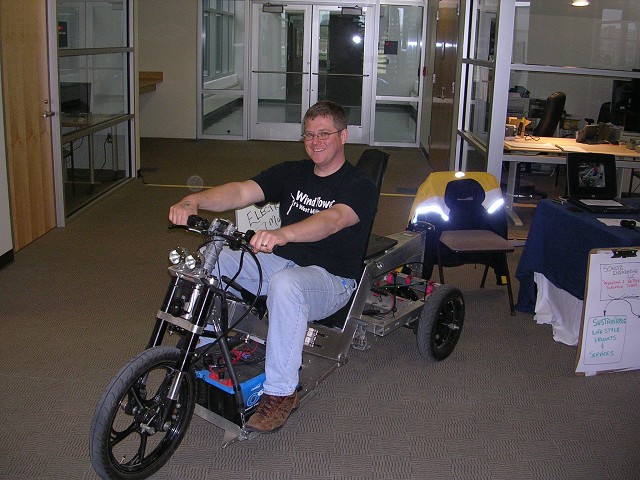 |
|
Plot of Power Vs. Speed with Cycle Analyst - April 29, 2012 The Cycle Analyst makes it easy to collect data for a chart like this... The Delta-11 proto-type on flat ground, calm day, 60 degrees farenheit. 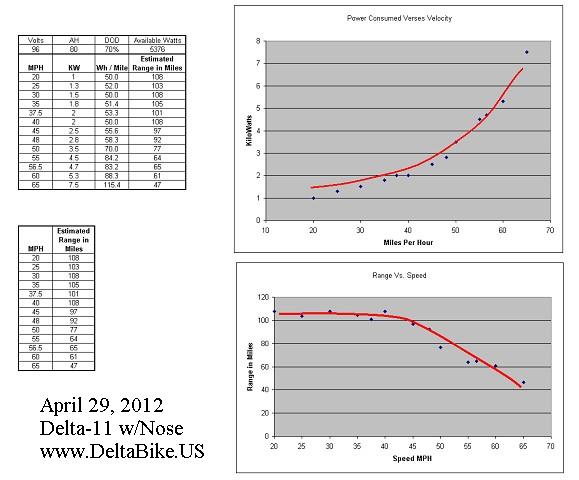 |
|
A Few Scratches, No Permanent Injuries - May 9, 2012 After 3,000+ miles of blemish free riding, I dropped the bike. Here's a nice shot of the bottom of the bike in case you wondered what it looks like. And yes, this bike is not easy to right. 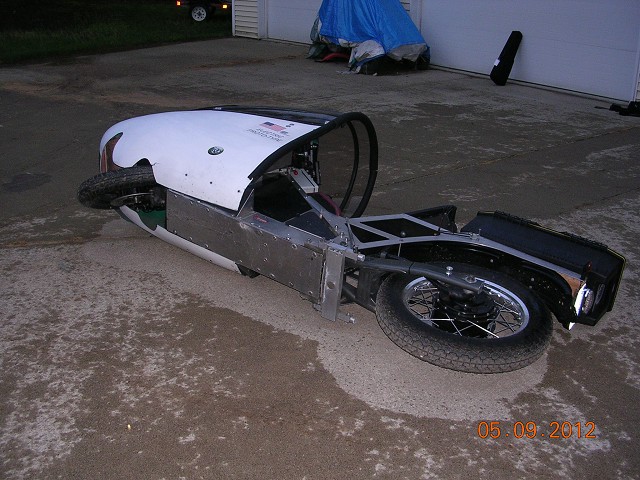 |
|
Courting Investors - May 17, 2012 We spent a silly amount of time courting investors this year. We caught a little money, but in the end, Kraig took a full time job at a local company to pay down his personal debt and get some money saved up for the next prototype build. Here are some Start Garden celebrities putting eyes on the Delta-11 prototype. Hindsight says, we should have had them suited up riding an electric bike, not just looking at one standing still.  |
|
76 Mile Ride Statistics- June 3, 2012 Inspired by the chart above (April 29th entry), I went on a long ride (76.8 miles) limiting my top speed to 45mph. I carried 48 lbs of gear (chargers, extension cords, back packs etc.) The bike handled well and the extra bag stacked on the top in the back seems to help cross wind stability and helps keep the air off the back of my neck. It's certainly nice to have all that extra storage space. There was a fair amount of city riding in the ride, which tended to hurt my fuel economy. The Cycle Analyst reported an average trip speed of 34mph and 63.3 Wh/Mile average consumption. The Cycle Analyst recorded 48AH consumed during the ride (of 54 AH available to hit a 70% Depth of Discharge mark) so, the maximum range at 45mph is estimated to be around 85 miles. It took 6.01 kW-Hours and 3:21 minutes to recharge from the wall per Kill A Watt meters resulting in a from the wall efficiency of 78.2 Wh/Mile at 45 mph. 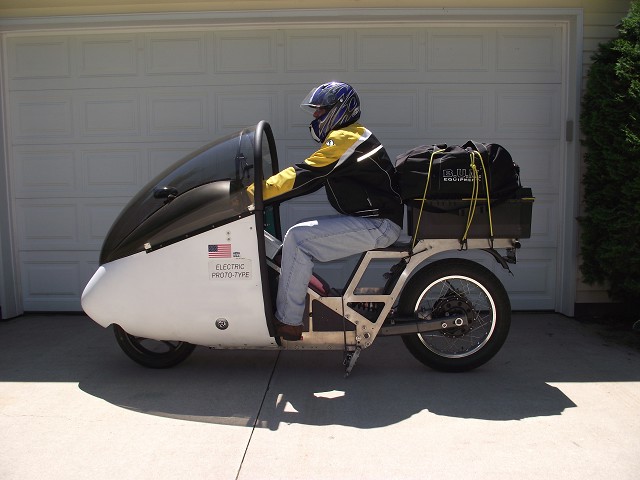 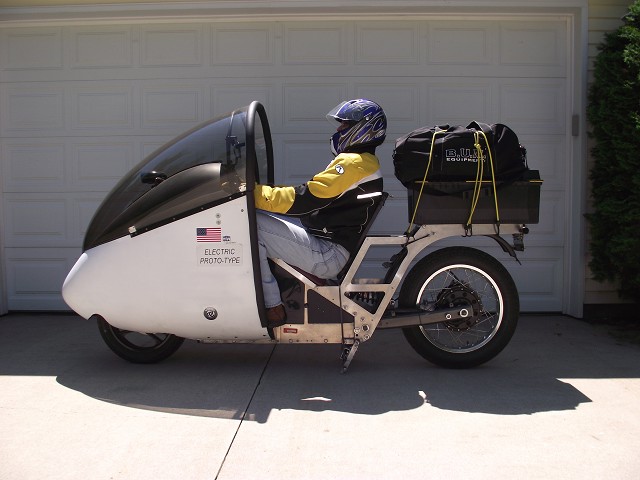 |
|
Livionia EV Show - June 9, 2012 We attended the 4th Annual Livonia Electric Vehicle Show. Ben Schultz with Fiskars 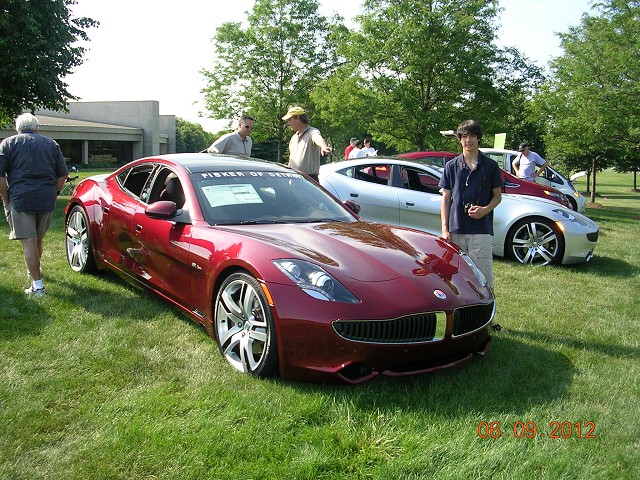 Kraig Schultz with Jack Chen of Enginer (our battery sponsor) with the Delta-11 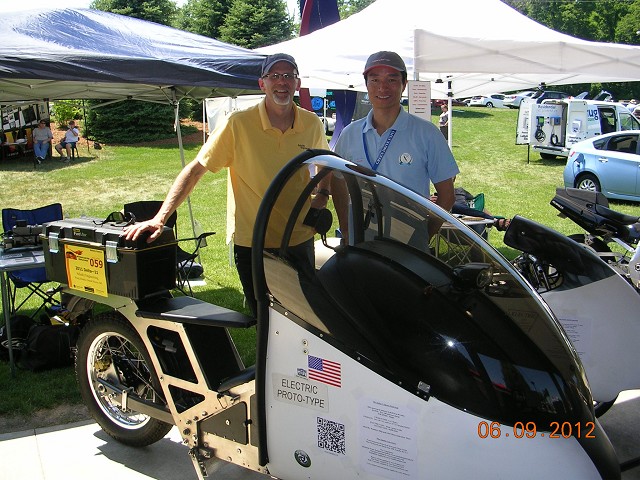 Nick Helmholdt, Kraig Schultz and Tony Helmholdt with Tony's E-Speed 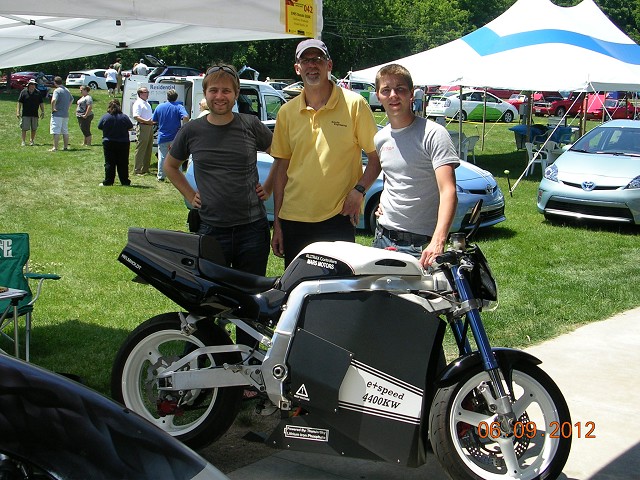 Kraig Schultz Receiving Trophy for Most Innovative EV from Larry Tuttle 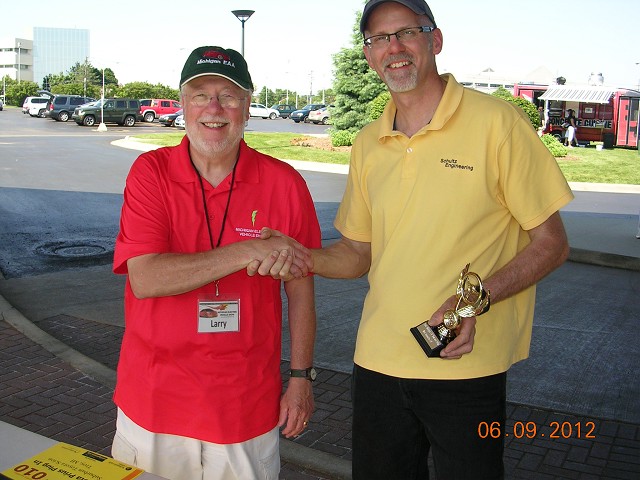 |
|
Helping Local Companies Innovate - June 2012 In June, while experimenting with concepts for our next prototype (X2 Firehawk) on our Honda 125S, 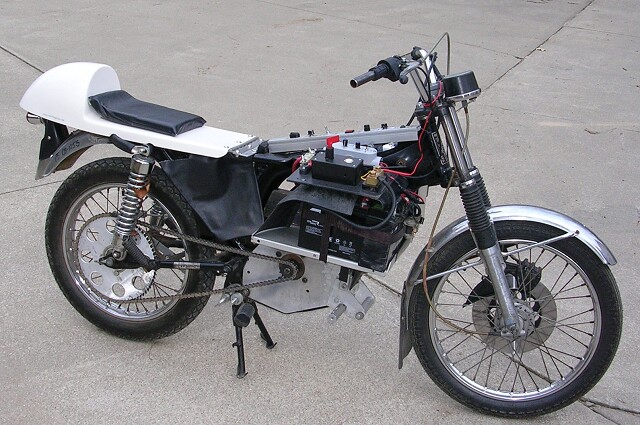 we started helping our friends in Zeeland develop an electric "Trail 70". We believe this project and all the things coming out of it will be a huge deal in West Michigan and in the history of electric motorcycles. Keep your eyes and ears open, our friends plan to introduce their bike to the market later this year. 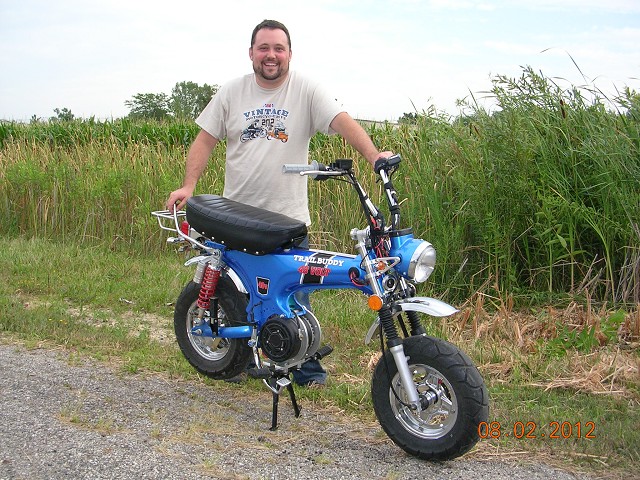 |
|
Installing Motor and Controller Upgrades - July 7, 2012 Parts to install 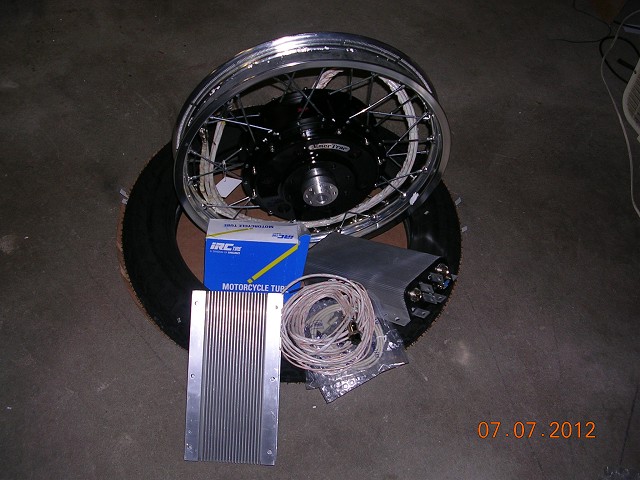 In process 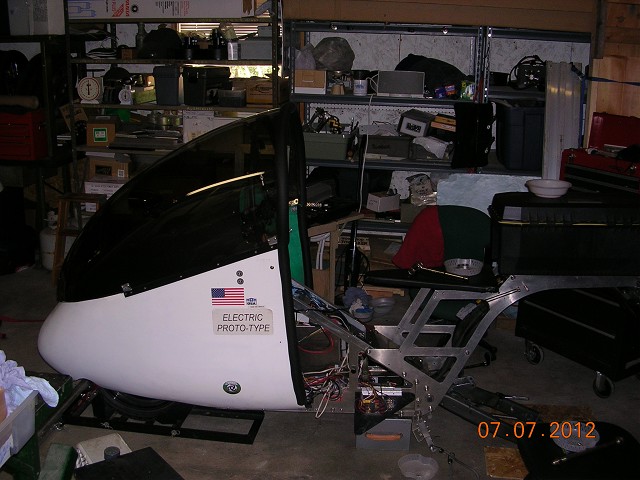 |
|
Mid-Ohio Electric Motorcycle Gathering - July 20-22, 2012 We helped gather thirteen electric motorcycles from across the county for the Electric Motorcycle Gathering at AMA Vintage Days and to participate in the Craig Vetter Fuel Economy Competition that took place July 20-22, 2012 at the Mid-Ohio Raceway. See 2012 Mid-Ohio Electric Motorcycle Gathering for a full report on the event. Electric Motorcyclists Left to Right: Seth Snyder (Schultz Engineering), John Lowitz (JMU), Sam Osterhout (JMU), John Edinger (JMU), Noah Podolefsky (Colorado), Mark Gelbien (Enertrac), Kraig Schultz (Schultz Engineering), Joe Ruva (Iowa), Thad Wolff, Kyle Ginaven (Ohio), Brian Richardson 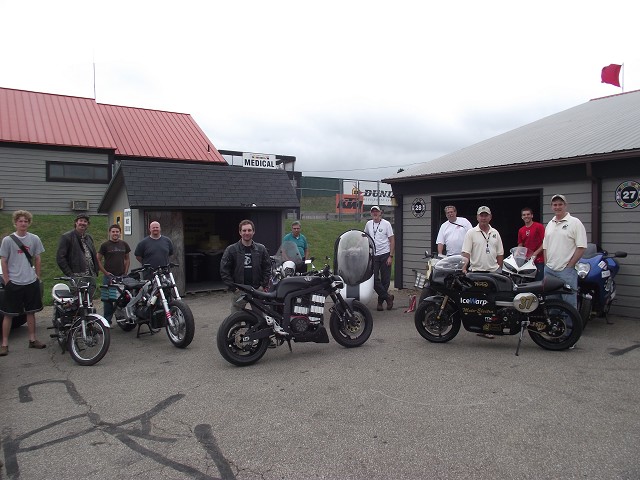 Pictures of the Gasoline Streamliner Group 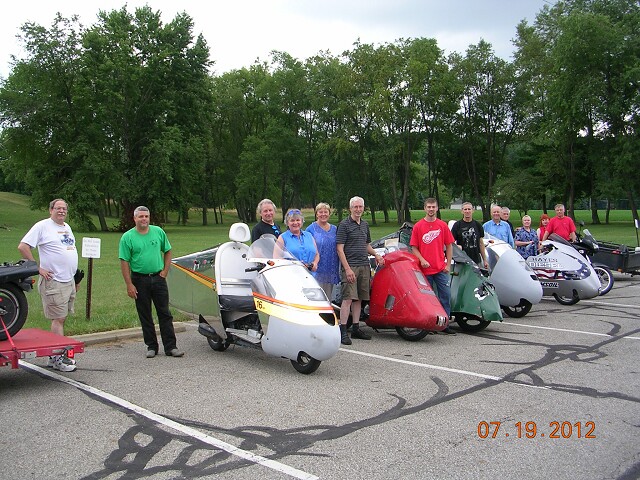 Saturday Night Dinner Ride 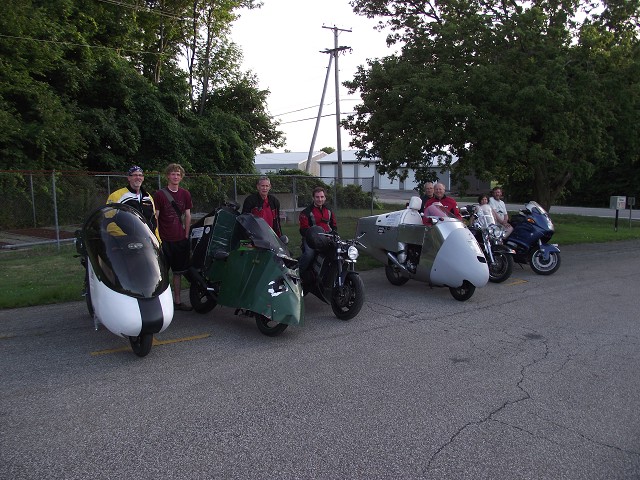 Does Kraig always scowl like this when he talks? 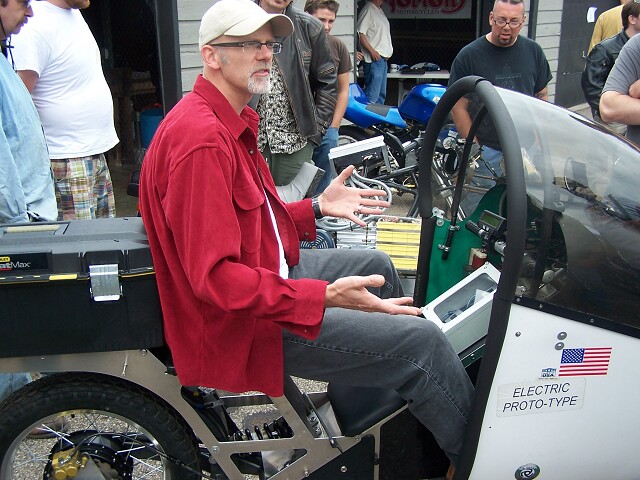 That's Better! 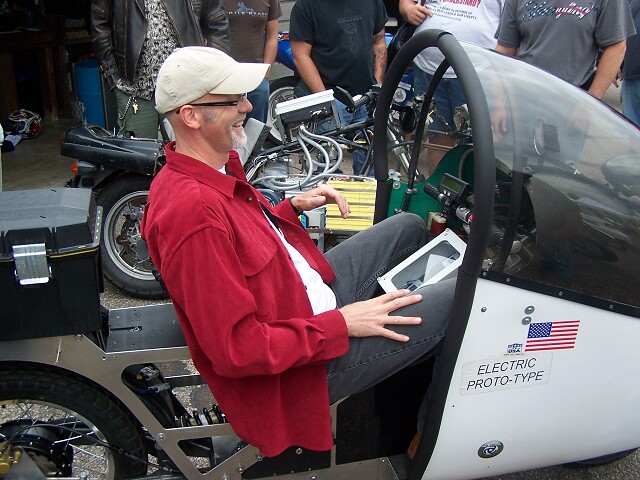 Getting ready for the Sunday Parade lap 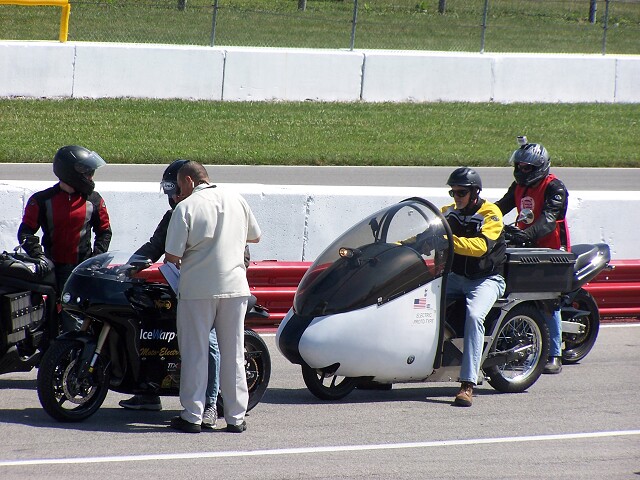 |
The Future of Electric Motorcycles - July 20-22, 2012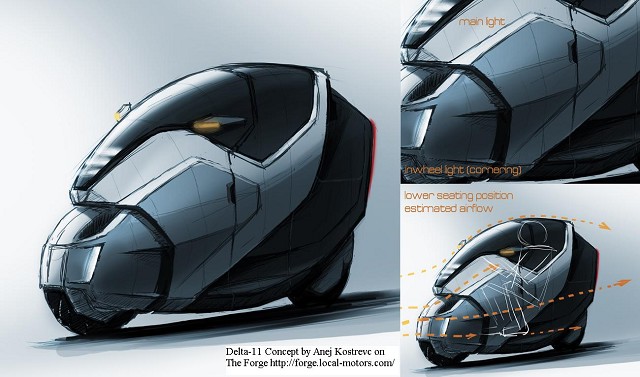 Kraig Schultz did two presentations on the Future of electric motorcycles at Vintage Days. Here is a link to the slides for those presentations www.deltabike.us/future.pdf The key points of the talk were as follow: Best Electric Motorcycles today get 100 Wh/Mile (337 MPGe) Biggest pack that will fit on bike today = 9.5kW usable 95 Mile range possible today 60 mile range at 55mph is practical commuting distance for some people today High price of electric bikes today is due to cost of electronics and batteries Batteries and fast recharging required for touring are 5 to 10 years out |
|
Funding Presentation - July 26, 2012 With the funding we recieved from Start Garden, we consulted with a marketing strategist and worked with an industrial designer to research what type of product would sell in the market place. On July 26, 2012, Kraig failed to convince our investor group that we were in touch with the market, cutting off further funding from Start Garden for 2012. 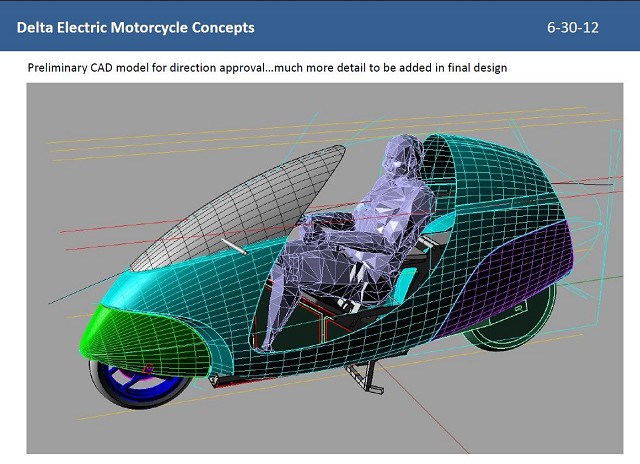 Relieved by not having to focus on funding, Kraig gets to work designing the next prototype. See delta-x2.htm for details. |
|
MetroCruise August 25, 2012 Tony Helmholdt and Kraig Schultz cruised around on electric motorcycles at the 2012 Metro Cruise event. 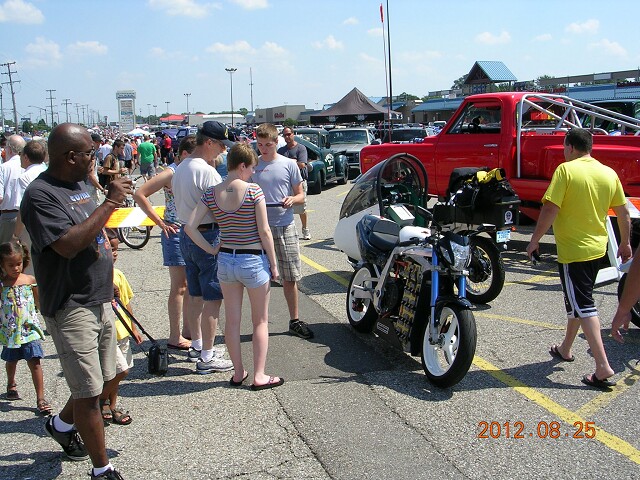 We noticed reserved parking spaces are being setup at various stores for fuel efficient vehicles! 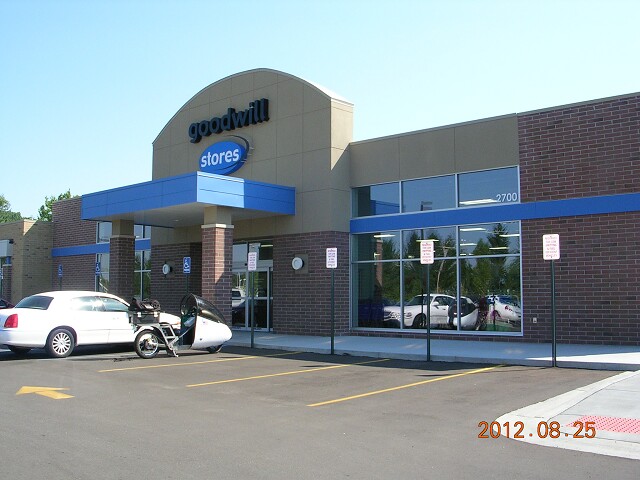 |
|
Doing research about our Local Nuclear Power Plant - September 2012 Beautiful day at the Beach - there were no "unacceptable levels radioactivity" released on this day. 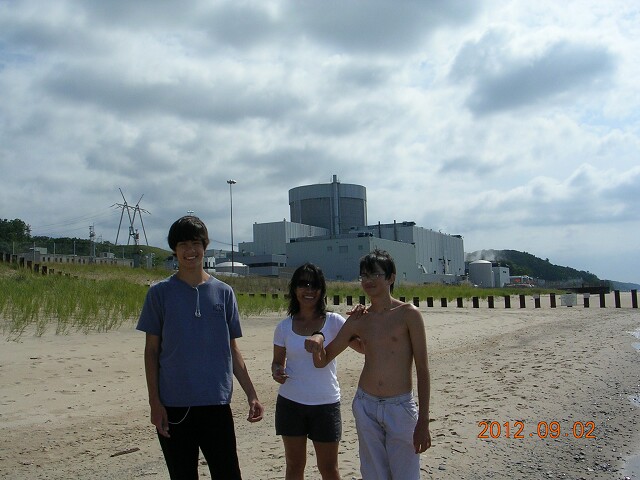 Please don't go too close! 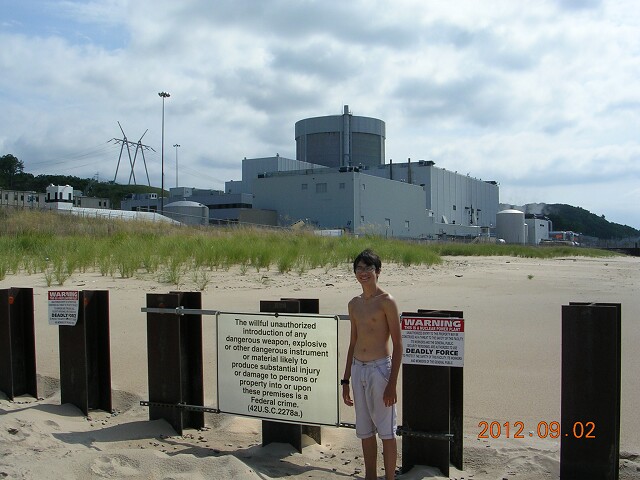 For our views on Nuclear Energy, visit hope.htm |
|
On- Board Chargers Cleaned Up - September 2012 Finally, the chargers were mounted on the bike with rubber isolation. The J1772 plug was installed on the very back of the tool box for quick hook up. 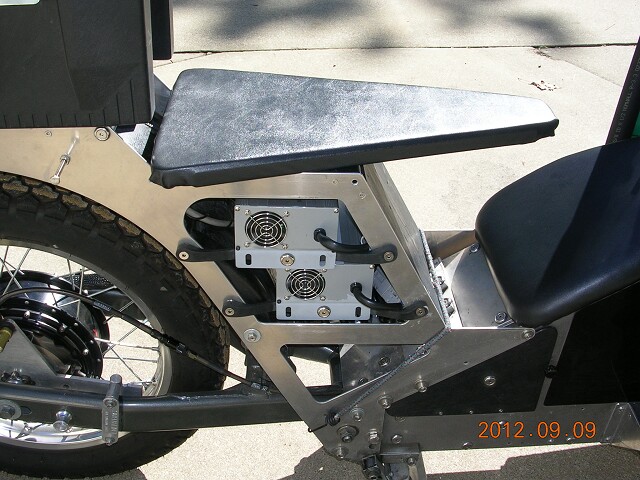 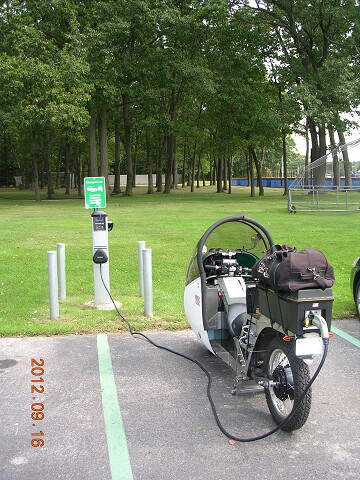 Inside the water proof toolbox, the 120VAC hook up allows for using Kill A Watt brand meters to measure energy consumed during charging. 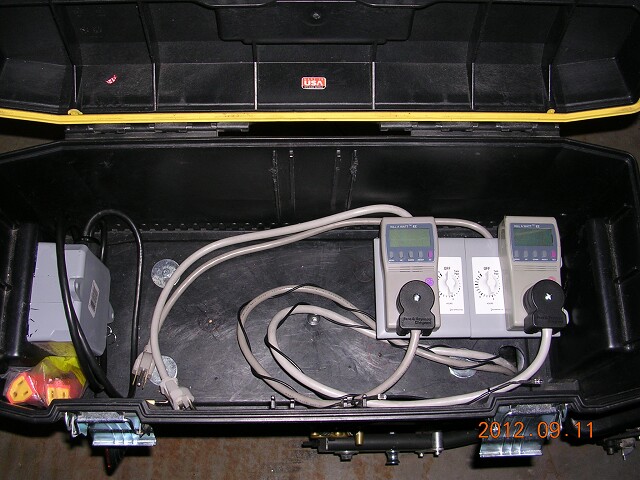 |
|
Art Prize - September 2012 It's been a busy summer, but Kraig's been out riding the Delta-11 prototype every chance he gets, commuting to work (34 mile round trip) and having fun. People really love the bike and gather around it whereever it goes. Here we spent some time at ArtPrize at a renewable energy functional artwork kiosk built by Brad Kalio of Zynoc. 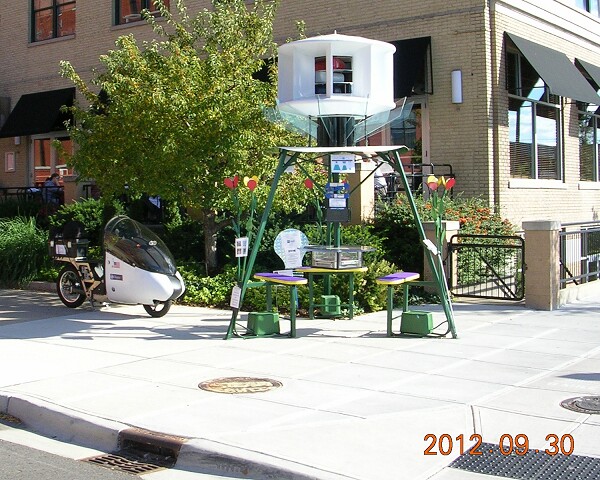 |
|
Charging Stations by Kraig - October 2012 I've been doing "Charging Station" research this month. First off, they are actually not "Charging Stations". They are just grid hookups for Electric vehicles and the correct term is EVSE (Electric Vehicle Supply Equipment). The going rate for a 30 Amp, J1772, Level 2, wall mounted EVSE unit is around $1,000. You can visit the Home Depot website and get a listing of 20 different units you can buy today. The more troubling question is, why do I need to spend $1,000 to plug my electric vehicle into to the dryer outlet, when a simple extension cord like on any RV would have done the same job? The answer is the J1772 standard is IDIOT proof. The old fashioned way of plugging in required you to have to think. You would need to turn the breaker in the cabinet off before plugging in to prevent arching and premature failure of the plug and outlet. My research into the EVSE stations indicates that the pricing of the stations can go down, but I don't expect that many merchants will purchase and install them. The main installation market will be in the home of everyone who buys an electric vehicle. Does it need to cost $1,000? No, in fact, the old fashioned hook ups you'll find at any campout "RV30" and "RV50" will do just fine. I'm planning to build a RV30 and RV50 pigtail to allow myself to plug in at campgrounds for my 2013 touring needs. 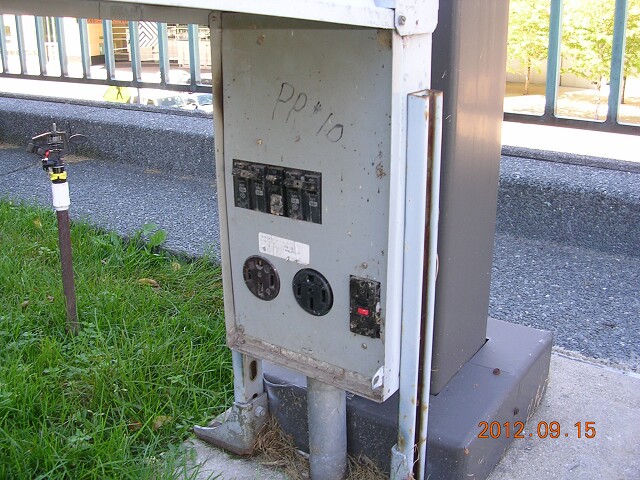 Here is the reason not many merchants will install charging units. You'll notice that two very UN-electric cars are parked in the electric vehicle charging parking spaces. I had planned to charge up here, only to find two gas gusslers parked illegally in my spot! 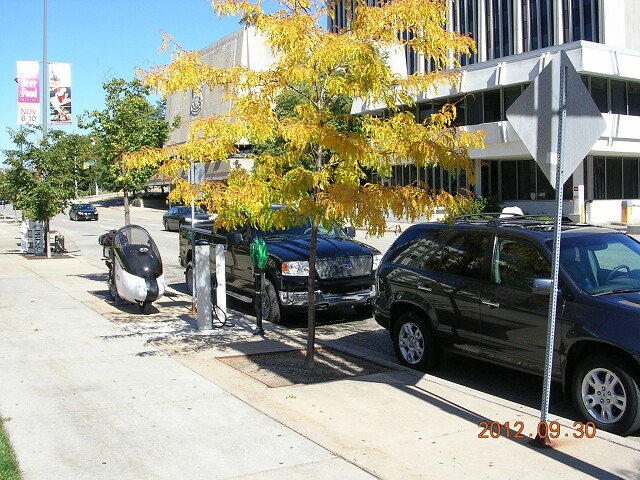 I thought about parking on the sidewalk and charging, but 2 weeks ago I got a ticket for doing that at the very same charging station.  So, The electric vehicle cannot plan on the charging station being available even if he reserves the spot! EVSE's that allow you to reserve them cost $8,000 plus installation, plus an annual fee. Only the Federal Government could justify such an investment. There will always be people trying to park in the electric vehicle spot (reserved or not). In this case, you will have unhappy electric car drivers (who cannot charge), and unhappy non-electric car drivers (who can't park there or get ticketed for doing so), and unhappy EVSE owners who paid a bunch of money only to get headaches in return. The answer is that the Electric vehicle driver will select a vehicle that has sufficient range to not need charging during the trip or he will have to pay a premium to own the EVSE and the parking spot. It's a catch-22 until large amounts of parking spaces are electrified. The best advice I can give a merchant on the EVSE installation location is this: install the EVSE in the most unused, undesirable location possible. That way, hopefully only someone really desparately needing a charge will park there. An excellent article recommending size requirements for charging stations can be viewed at http://www.todaysengineer.org/2012/feb/ev-charging.asp or can be downloaded directly level1.pdf Another even better article can be found at http://aprs.org/payin-to-plugin.html or can be downloaded directly level1a.pdf |
|
Kraig Reports on Longest Ride of the Year, Highest Average Speed, Deepest Battery Draw Down Ever - October 12, 2012 I rode down to Kalamazoo to test drive some Zero motorcycles. It was 76 miles down there and 75.3 miles back. Total Trip: 151.3 Miles, kW-hrs: 13.85, Wh/Mile: 91.6, Average speed for entire trip: 48.3mph On the way down it was 45 degrees F and I rode 45mph. I took a few wrong turns on the way down and ended up having one of my cells in my external pack go over the cliff just before I got to the dealer at (65-70 miles into ride. Fortunately, the salesperson at the dealership asked me if I wanted to plug in (which I gladly did and got a .5kW-Hr charge on my weak pack) while I was doing my test rides. Sucking life from the grid at Life Cycle...(picture source www.facebook.com/110friendly)   After leaving the Zero Dealership, I went to Western Michigan University (WMU) to get a full recharge (5.974 kW-Hrs = 3.5 hr charge) while having dinner and exploring the campus. My BMS was warning low voltage on the internal pack by the time I got to WMU so, I learned my actual battery pack capacity (for both packs) is around 46 amp hours (at 45mph, 96volts and 45 degrees F). On the ride home, I took the highway from Kalamazoo to Downtown Grand Rapids (40 degrees F, did 45 miles at 60mph on the highway, drafting on cars to save energy) where picked up another charge (2.587 kW-hrs = 1.5 hrs). I then rode home at posted speed limits of 45-55mph. Total trip home 75.3 miles, charged up at home (4.79 kW-hrs). Note: I was at the brink of going over the edge with my external battery pack when getting into Grand Rapids. This was at about 42 amp hours (at 60mph, 96volts and 40 degrees F). What this means is that my safe range in cold weather is around 45 miles at 55mph speeds. (Cold air is denser causing lower efficiency and cold batteries can't give up as much power). These pictures show voltage (Y Axis) of the 16 cells in each pack over the course of this ride including recharges. It's a good graph to show how a Lithium Iron Phosphate Battery charges and discharges. 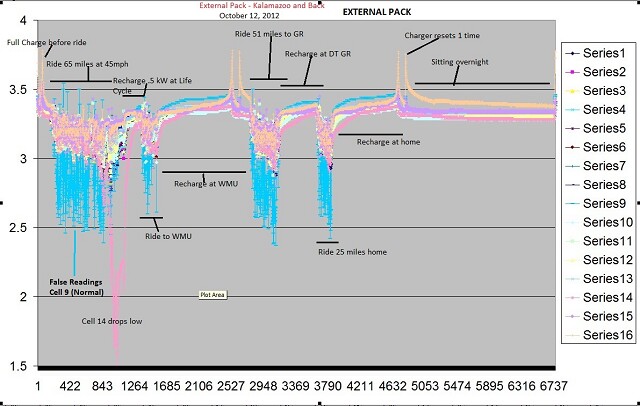 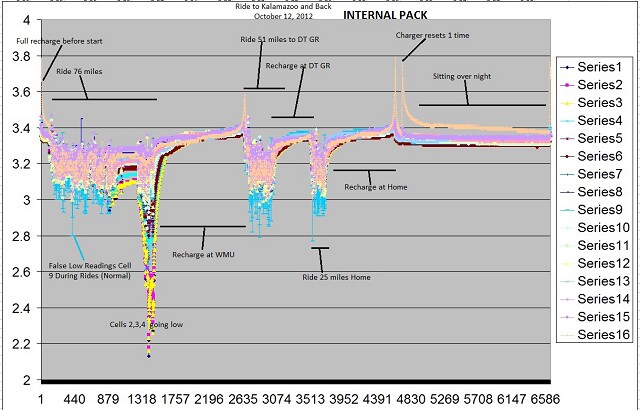 |
|
Zero Motorcycle Test Drive Report by Kraig - October 12, 2012 I'm hoping to use a Zero as a donor bike for the X2 concept bike. So, I rode down to Kalamazoo to test drive some Zero motorcycles and enter the drawing for a giveaway bike. I test rode two bikes from Life Cycle Motorcycle Shop in Kalamazoo, Michigan. The 2011 Zero UA with chain drive and a 3kW pack was solid, but so docile that I brought it back to the dealership after riding it less than a mile. 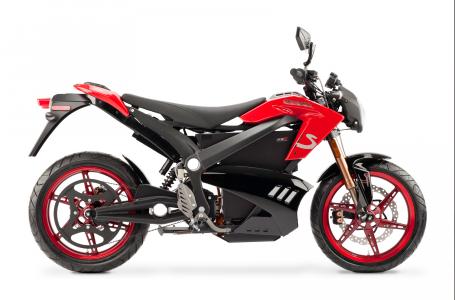 The 2012 Zero S (pictured above) with belt drive and 9 kW pack was rock solid and very well behaved. It had very nice brakes, steering, manuverability, suspension and strong acceleration from 10-60 mph. I did not test the top speed as I'm not familiar with the area and I don't need any more speeding tickets. The regenative braking is setup to be a no brainer. When you let off on the throttle it goes into regen acting just like engine braking. But, since there is no clutch, you can't coast, other than by "feathering" the throttle to find the spot where you are not accelerating or braking. The "S" I rode, had one problem. When I twisted the throttle from a standing stop, it gave a disappointing lack of commotion. There was no noise and little acceleration while the bike creeped forward and gradually and gained more and more acceleration. It rode a lot like a gas bike stuck in 2nd or 3rd gear only since you can't hear the engine lugging, you have nothing giving you positive feedback. It had no amp meter so I couldn't tell if the motor was hogging amps or if it is programmed or geared to be flat in this range. It's probably a little of each. Running a relatively low 66 voltage system with top speed of 88mph is a stretch for having excellent launch torque without huge amperage draws. I was expecting the Zero S with its 420 amp controller to be able to take off like a rocket. Instead the bike seemed to have no possibility of doing a wheelie or of burning rubber. This made the bike perfectly safe, predictable, and controllable (since I didn't need to worry about loosing traction by lifting the front wheel or spinning the rear wheel). But, while this is safe and may give excellent results for riding control, it didn't make the bike exciting. When I tell my bike to go, I want it to GO! The bike had 2 switch positions "ECO" and "SPORT". I think it could use a third switch position; it would be labeled "EXCITING". So, how to ride this bike? Just crank the throttle wide open and aim it where you want it to go. It will accelerate perfectly every time, so, in that way, it's like a high powered scooter and a great bike for just enjoying the surroundings - the bike takes care of itself and gives you everything it can; safely. MORE THOUGHTS ON THROTTLE RESPONSE: Is the bike just geared wrong? Or is it programmed to be tame? Any time you hit the throttle in the 10-50mph range it was very responsive. Why is this a problem? I don't think it would be a problem if there were some kind of feedback at take-off for you to know that the bike is working hard for you even though you don't feel it YET. For instance, if I turned the throttle and some high tech roar started eminating from it's guts, I'd be happy, because like Captain Kirk I like to be reassured "I'm giving it all she's got captain". One other note: the bike seemed small for my 6'2" height. I had a tendancy to be sitting on transition from the rear fender to the seat. Summary: The Zero S would make a good donor for Delta-X2, the UA would not. For the X2, I'd entertain lowering the gear ratio to reduce the top speed to 70mph to give it a 25% more acceleration off the line, I'd install a three-position switch and tune the bike to match three settings: "Docile", "Sporty", and "Dangerous". September 28, 2013 UPDATE: On September 28, 2013, I took a 2013 Zero DS with 11.9 battery for a test drive and I am pleased to announce Zero has worked out their drive train bugs. The bike is tuned very well for power and is simply amazing. I recommend EVERY motorcycle rider goes out and takes a 2013 Zero for a test ride. Nothing will convince you quicker than a test ride, electrics are the future. |
|
Riding Season Summary - November 1, 2012 There are few days of riding left this year, but the deer are jumpy, it's cold, rainy and windy and the ride to work is dark, so it's a good time to put the bike away and share some data from the 2012 riding season. Total Number of Trips: 77 Miles Traveled in 2012: 3,188 kW Hours Electricity to Charge: 304 Cost of kW/Hour: $.15 Recharge Efficiency: 80% Total Fuel Cost: $45.59 Fuel Cost/Mile: $.0143 Average Wh/Mile: 95.3 MPGe: 353 Average Trip Speed: 37.9 mph Average Trip Distance: 41.4 miles Total Miles on Prototype: 5,915 The Cycle Analyst Gage helped us learn about some things we hadn't realized before. For instance, it's very hard to get an average trip speed over 40mph in commuter traffic. Here you can see the average trip distance. Kraig's daily commute to work of 35 miles really stands out on this chart. 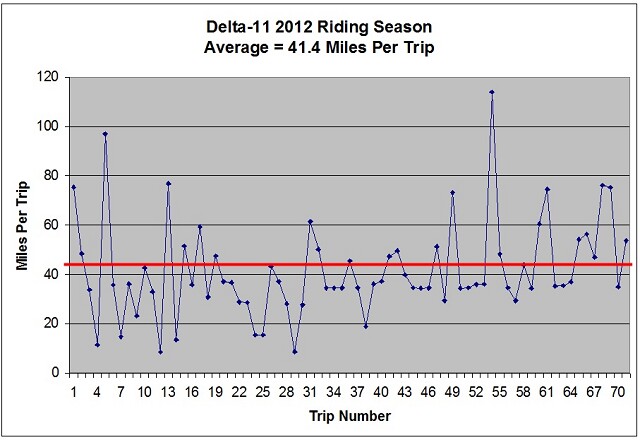 This chart shows watt hours per mile FROM the Wall. Overall average for the season was 95.3 Wh/Mile which converts to 350 MPGe. 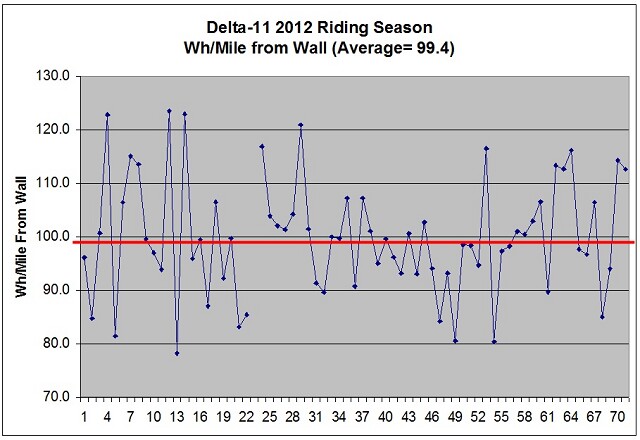 It's expected that the faster you ride, the more fuel you consume. But, this chart shows little correlation between average speed and Wh/Mile. Unlike most electric motorcycles, the Delta-11 prototype gets about the same fuel economy in the city as it does on the highway because of it's weight and aerodynamics. The low fuel efficiency is not good, electrics normally get BETTER fuel economy in the city than on the highway. This data highlights why our next prototype will be much lighter in weight. 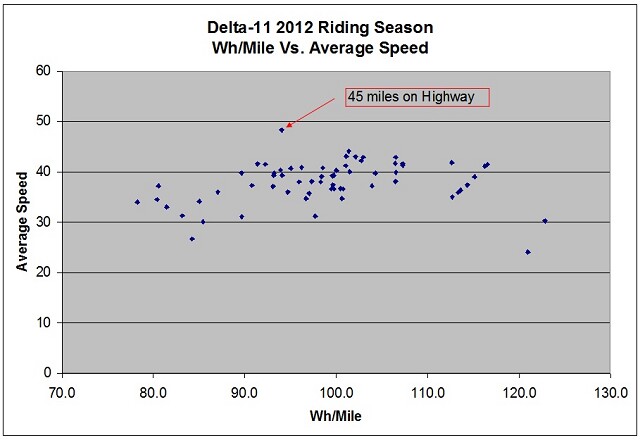 Recharge efficiency is the ratio of what is used by the vehicle from the batteries during the ride to the amount of energy it takes to recharge the batteries. The difference is primarily lost to heat from the chargers converting AC to DC voltage, but there is also heat lost in batteries as chemical reactions are happening and heat lost in the wires connecting everything. Experience shows that good heat sinking/ventilation/fans are required to keep chargers cool during charging. 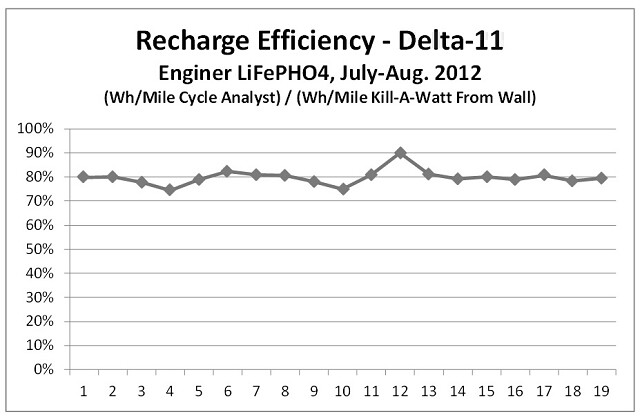 To put it all in perspective. Here is the MPGe chart showing a daily 34 mile commute keeping pace with traffic going to and from work. Our 1994 Plymouth Voyager Mini Van averages 18-21 MPG driving this same commute at the same speeds/accelerations. This chart shows a downward trend that matches the cooler temperatures toward the end of the riding season. 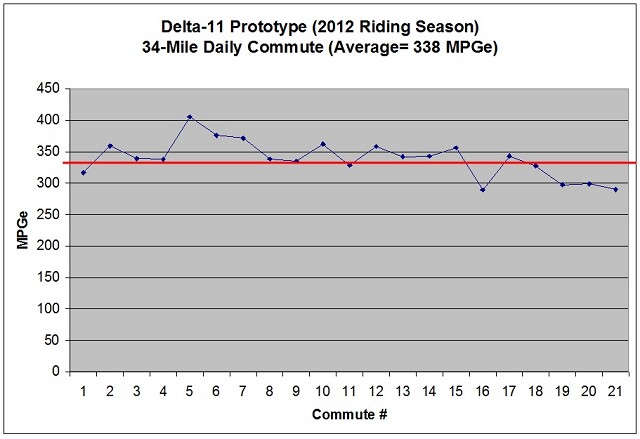 |
|
ESTIMATED EPA MPGe November 1, 2012 The following Wikipedia article outlines how MPGe is calculated for Hybrid and Electric cars. See http://en.wikipedia.org/wiki/Mpge. The formula is MPGe = (33,705 watt hours/gallon of gas) / (watt hours/mile consumed during EPA's 5 drive cycle tests for electric cars) Now, we did not do the EPA's 5 drive cycle tests, so the following MPGe chart is only a estimatation of MPGe for the Delta-11 based on REAL WORLD riding: For the 2012 Riding Season we averaged 95.3 watt hours per mile in 3,188 miles of REAL WORLD riding. That is the equivalent of about 350 MPGe. |
|
Tail Concept for the Delta-11- December 15, 2012 Kicking around various ideas for a tail shape to build for the Delta-11. 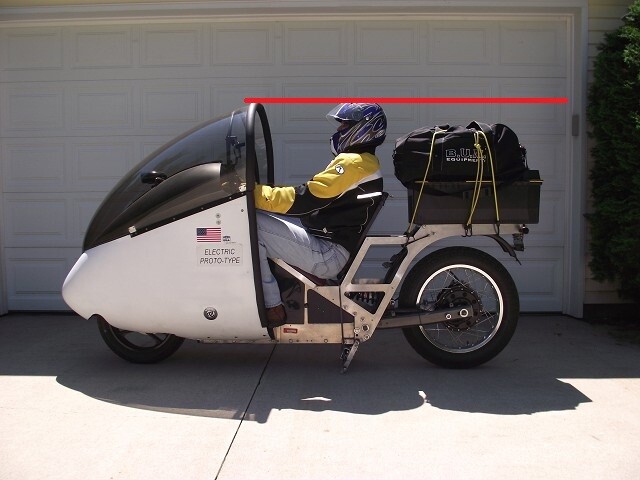 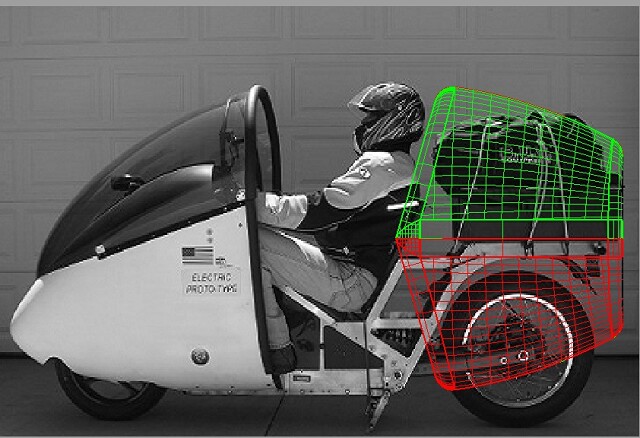 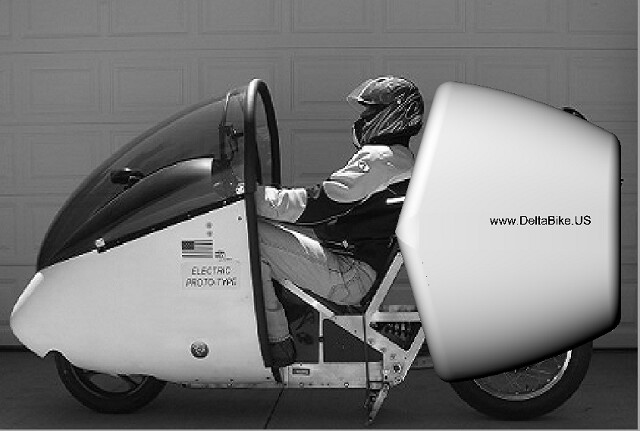 The Delta-11 project has given us practical electric commuting vehicle experience. The experiences gained from two years of riding will be rolled into the next prototype. We are designing our next bike to specifically meet the needs of the market place. To learn more about it visit delta-x2.htm |
|
A123 Battery's - In the Delta-11 Prototype? The A123 batteries have caused a lot of excitement this year with people who are actually building EV's. A source has been leaking 20A pouch cells to the market from China. Before the leak, the A123 batteries were only available to major OEM's. After the leak, they have become the best battery value in the history of mankind. A123 has a wonderful modular way of packaging the cells. The pouches can be in series and/or parallel to suit voltage and current requirements of the application. Cell balancing is accomplished by an electronics board mounted neatly next to the cells. It's a beautiful battery package, but most important is the Chemistry. These batteries have an power density closer to LiPO (10C-18C rating) but with the safety and cycle-life of LiFePO4. 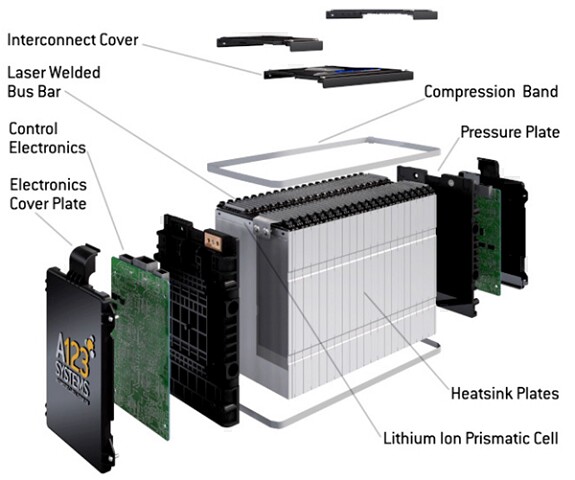 What if we loaded up the Delta-11 prototype with A123 battery modules? Let's say, we put six, 12V 80Ah battery packs inside the bike, and two, 12V 80Ah Battery packs on the exterior. This would reduce weight currently in the exterior packs and lower the center of gravity, while giving much needed knee room. At $20/pouch here is the estimated cost for the cells. 4S4P = 13.2V 80AH Battery = 16 pounches x $20 each = $320 each x 8 modules = $2,560 With 80AH cells at 10C we could pull 800AMPS! Suddenly, we're not limited by the batteries! We've been limiting our bike to 1/10 it's potential because of the batteries. Now, instead of being just fun to ride, it will become TO DIE FOR EXCITING! |
|
Predictions about the Future of Electric Touring by Kraig Schultz - Fall 2012 In August 2012, Craig Vetter asked if I was planning to ride across the United States in 2014 in the Don Emde Cannon Ball ride. Here is my answer. "Yes, I'm interested in something like the Cannon Ball ride. One of my life "goals" is to ride across America in a vehicle I built, so this this might be an opportunity to do it. I disagree with the idea of battery swapping. I feel we have the capability to tour "naturally" today. Let me give you some quotes from my "Future of Electric Motorcycles" presentation to help describe what I mean by "natural touring". Before the industrial revolution, we would travel until our bodies or our horses needed to stop for food and water. We would rest and then we would move on. With the introduction of automobiles and Interstates the nature of travel changed. We gained the ability to travel great distances quickly but lost touch with the "journey". Can an Electric Motorcycle Tour today? - Yes, in 2012 we can build a motorcycle that will go 100 miles between charges, with 3 hour recharge times, we can travel 200 to 300 miles/day. This is about the distances that Cannon Ball was doing. Our advantage is that we will be able to enjoy the trip much more than he did, because when we are riding our average speed will be much higher than his was (he was riding on unpaved surfaces). We'll get quickly to our destinations, and put the bikes on charge, do sightseeing, publicity talks, rest, eat, and then leave for the next stop refreshed. "When Will the Next Battery Arrive? My opinion is that we're at least 5 years away from a 10x improvement in battery capacity. So, we need to work with the energy density we have today. And this is about 1/100th the energy density of Gasoline." Gasoline = 44 MJ/Kg (12,222 Wh/Kg) and 34.8MJ/L (9,667 Wh/L) LiFePO4 Battery = 100 Wh/Kg and 150 Wh/L "But, Why wait for a better battery? With LiFePO4 battery we have a practical commuter vehicle today, and with better Aerodynamics, we can make a practical touring machine with the following qualification in the definition of "touring"." "I'd like to propose that "Touring" is better off the Interstate and with frequent sideways excursions and stops. Therefore, the ideal Electric touring vehicle should be light and nimble enough to explore the countryside on all types of roads and trails, while retaining the ability to cruise the interstate in comfort (i.e. travel at 70mph for up to 100 mile distances)." "I'd like to propose that we change the focus of our tour from how quickly we can travel the miles to how much we can maximize the experience of visiting each stop along the way (by stopping frequently and seeing the sights as we go...and recharging our batteries while we are stopped, our bikes will be fully charged each time we are ready to ride to the next stopping point)." Another thing to consider is that by 2014, I predict we can build an electric motorcycle that can travel 150 miles at 55mph on one charge (via improved aerodynamics and battery chemistry). So, yes, I'm interested in electric motorcycle touring, if we will actually be touring. If, however, we are just trying to set speed records, then perhaps not." Kraig Schultz |
|
(Next Page) |
|
Inventing a better tomorrow today... Copyright 2012, Schultz Engineering, LLC, written by Kraig Schultz |